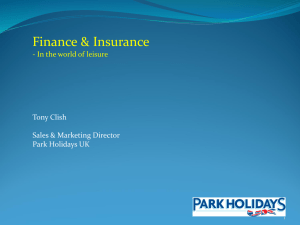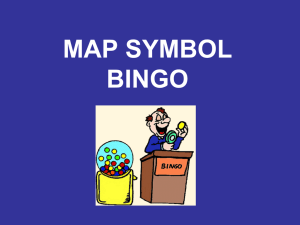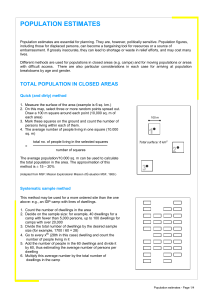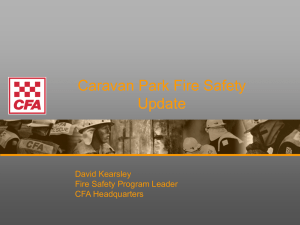Practice Note 2 - Movable Dwellings in Caravan Parks
advertisement
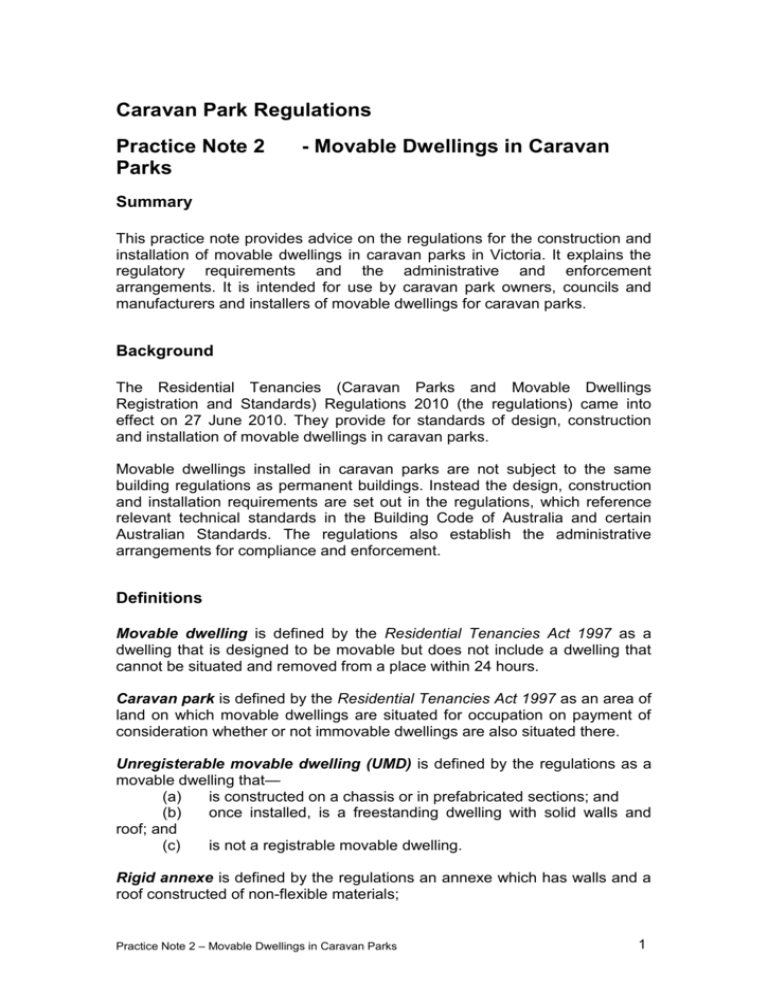
Caravan Park Regulations Practice Note 2 Parks - Movable Dwellings in Caravan Summary This practice note provides advice on the regulations for the construction and installation of movable dwellings in caravan parks in Victoria. It explains the regulatory requirements and the administrative and enforcement arrangements. It is intended for use by caravan park owners, councils and manufacturers and installers of movable dwellings for caravan parks. Background The Residential Tenancies (Caravan Parks and Movable Dwellings Registration and Standards) Regulations 2010 (the regulations) came into effect on 27 June 2010. They provide for standards of design, construction and installation of movable dwellings in caravan parks. Movable dwellings installed in caravan parks are not subject to the same building regulations as permanent buildings. Instead the design, construction and installation requirements are set out in the regulations, which reference relevant technical standards in the Building Code of Australia and certain Australian Standards. The regulations also establish the administrative arrangements for compliance and enforcement. Definitions Movable dwelling is defined by the Residential Tenancies Act 1997 as a dwelling that is designed to be movable but does not include a dwelling that cannot be situated and removed from a place within 24 hours. Caravan park is defined by the Residential Tenancies Act 1997 as an area of land on which movable dwellings are situated for occupation on payment of consideration whether or not immovable dwellings are also situated there. Unregisterable movable dwelling (UMD) is defined by the regulations as a movable dwelling that— (a) is constructed on a chassis or in prefabricated sections; and (b) once installed, is a freestanding dwelling with solid walls and roof; and (c) is not a registrable movable dwelling. Rigid annexe is defined by the regulations an annexe which has walls and a roof constructed of non-flexible materials; Practice Note 2 – Movable Dwellings in Caravan Parks 1 Caravan Parks and the Building Act 1993 Section 517 of the Residential Tenancies Act 1997 excludes movable dwellings in caravan parks from the Building Act 1993 (except for Part 12A plumbing works). This means that building permits are not required for the construction and installation of any UMD or rigid annexe in a caravan park. Local council is the authority responsible for enforcement of non-compliance. The enforcement provisions are contained within the Residential Tenancies Act 1997 and the regulations. It is an offence for someone to construct or install a UMD or rigid annexe in a caravan park unless it complies with the regulations. Where a UMD or rigid annexe is installed in a caravan park it is important that the new dwelling does not compromise the caravan park’s fire safety as required by Regulation 21 including fire separation distances. Incorporated Documents: The regulations refer to technical documents for the standards and specifications which need to be adhered to in the construction and installation of movable dwellings in caravan parks: Building Code of Australia The Building Code of Australia (the BCA) is a national code containing technical specifications and standards for construction. The regulations refer to the BCA Volume 2 for the technical standards for the construction of UMDs. A UMD is considered to be a Class 1 building for the purposes of compliance with any of the required provisions of the BCA. The Department of Planning and Community Development monitors the annual BCA updates for relevance to the caravan park industry and will issue information on the DPCD website to inform industry and councils of relevant changes. Australian Standards AS/NZS 1170 "Structural Design Actions” specifies certain pressure actions to be used in the limit state design of structures and parts of structures. It is relied upon by the technical specifications for structural integrity in relation to the construction and installation of rigid annexes in caravan parks. AS 1288 “Glass in Buildings – selection and installation” sets out procedures for the selection and installation of glass in buildings, subject to wind loading Practice Note 2 – Movable Dwellings in Caravan Parks 2 and human impact. It is relied upon by the technical specifications for the construction of rigid annexes. The Regulatory Requirements What do the regulations do? The regulations set out requirements which provide for structural integrity for movable dwellings. They specify that movable dwellings must be constructed in accordance with certain technical standards which are set out in the BCA and/or certain Australian Standards. The regulations also put in place a self certification system and a local council enforcement process. The regulations place obligations on manufacturers of UMDs or rigid annexes and those installing them in caravan parks to do so in accordance with certain technical specifications set out in the schedules to the Regulations and also in the BCA for UMDs and AS/NZS 1170 for rigid annexes. There are also requirements for all movable dwellings to be correctly fitted with working smoke alarms. The regulations also set out administrative arrangements which include requiring a compliance plate to be fitted to a newly constructed movable dwelling and certain notices to the council relating to the installation of a movable dwelling. The relevant local council can prosecute any breach of these regulations and failure to comply carries a maximum penalty (for each offence) of 10 penalty units which is equal to $1221.40 as at 1 July 2011. How do they apply? The manufacturer of a UMD or rigid annexe to be installed in a caravan park is responsible for ensuring that the dwelling is constructed in accordance with the relevant technical specifications referenced in the regulations. For a UMD these are the relevant parts of the BCA (those sections which do not apply are listed in the regulations in Part 1 of Schedule 3). Part 2 of Schedule 3 also contains technical specifications relevant to the construction and installation of a UMD. For a rigid annexe, the technical specifications are set out in the regulations in Part 3 of Schedule 3. These refer to AS/NZS 1170 for the structural integrity of the dwelling. The manufacturer must permanently fix a compliance plate onto the dwelling which certifies that it has been constructed in accordance with the regulations. A new compliance plate should be provided if additions (such as a deck or Practice Note 2 – Movable Dwellings in Caravan Parks 3 verandah) or alterations (such as increasing the size of a dwelling) are undertaken following installation. A movable dwelling must not be installed in a caravan park unless it has a compliance plate. When a new movable dwelling is sold, a set of installation designs prepared by the manufacturer has to accompany the sale. When it is proposed to install a movable dwelling in a caravan park, the caravan park owner must provide the relevant local council with a notice which contains details of the proposed installation including siting, dwelling design and installation details. Following installation the person who installs a UMD or rigid annexe in a caravan park must supply the owner of the dwelling with an installation certificate which certifies that the installation has been carried out in accordance with the regulations. The owner must then provide a copy of this certificate to both the caravan park owner and the relevant local council within 7 days of installation (regulation 40). A UMD which was constructed before 27 June 2011 which complies with 1999 regulations is taken to comply with the regulations even if it is being relocated to a new site or park (as set out in the transitional arrangements at regulation 48). It does not need to be upgraded or altered to meet the 2010 regulations, and it does not require a new compliance plate. However, if it is being relocated, it must be installed in accordance with the 2010 regulations. Decks and Verandahs A deck or verandah which is attached to a movable dwelling in a caravan park is taken to form part of the dwelling to which they are attached. As part of a movable dwelling which is exempt from the Building Act, any such deck or verandah would also be considered to be exempt. Any deck or verandah which is attached to an existing dwelling (and is therefore taken to form part of the dwelling) must be constructed in accordance with the design, construction and installation standards as set out in regulations 33 (UMDs) and 34 (Annexes) and the technical specifications set out in Schedule 3 of the regulations. In the case of a deck or verandah attached to a rigid annexe this includes the requirements set out in Schedule 3 5(7). A deck or verandah attached to a rigid annexe should not be considered as part of the enclosed space of the annexe. This means that a deck or verandah is able to extend past the body of the movable dwelling or extend an annexe to a width greater than 3.6 metres. In such cases, there is an obligation on the person who constructs and installs the annexe, deck or verandah to ensure that all elements of the dwelling are structurally sound and comply with the relevant requirements of Schedule 3. Practice Note 2 – Movable Dwellings in Caravan Parks 4 There is also an obligation on the caravan park owner to ensure that where a new deck or verandah is attached to an existing dwelling the existing fire separation distances for the dwelling are maintained. Stand Alone UMD “en-suites” Within these regulations “en-suite” style free standing bathroom facilities provided on sites for use with individual caravans are understood to be UMDs and therefore are not subject to the Building Act 1993 (except for Part 12A plumbing works). The construction and installation of these types of UMDs must be in accordance with these regulations, including the requirement for a compliance plate, and the technical specifications set out in the BCA and in Schedule 3. Carports A carport, shed or garage adjacent to a movable dwelling in a caravan park is subject to the Building Act 1993. These structures may or may not be subject to building permits, depending on their size. Local council or a registered building surveyor will be able to advise a caravan park owner if a building permit is required. Plumbing Work The exemption of movable dwellings from the operation of the Building Act 1993 does not include Part 12A (plumbing work). This means that Part 12A as well as the Plumbing Regulations 2008 do apply to all plumbing works carried out on movable dwellings in caravan parks and equally to any plumbing work carried out in the park itself (such as fire hydrants or sanitary drainage). Additionally, any standards called up by the Plumbing Regulations 2008 also apply. A person must be registered and/or licensed by the Plumbing Industry Commission before carrying out plumbing work and must not carry out work of a particular class or type unless he or she is licensed and/or registered to carry out work of that class or type. Any gas fitting work, below-ground sanitary drainage works, or any plumbing work which costs in excess of $750.00 must be certified. A licensed plumbing practitioner must undertake the works and issue a compliance certificate within 5 days of the completion of the works. Examples of plumbing work which may occur in a caravan park include: Class of Examples work Roofing Metal roof sheeting, gutters and downpipes on annexes and buildings including water tanks Water Water mains within park, cold water pipe work in UMDs, Practice Note 2 – Movable Dwellings in Caravan Parks 5 supply Gasfitting Sanitary work Drainage work Fire protection Split systems annexes and en-suites, heated water pipe work, installation of ablution fixtures using heated water, all backflow prevention works. All work on park gas mains, all gas fitting lines, installation/servicing of all gas-using appliances in caravans, UMDs, annexes and en-suites or buildings in the park. All waste pipes in caravan park amenities/laundry facilities, all waste pipes from movable dwellings to park infrastructure, installation of sanitary fixtures in movable dwellings Below ground stormwater and sewerage drains within the caravan park, below ground connections from vans/annexes etc to the caravan park infrastructure. Installation of hydrants, hose reels and fire sprinkler systems. (NB: this work is plumbing work not building work – a building permit is not required. The installation of split system air conditioners is classed as mechanical services work. It must be carried out by a licensed plumbing practitioner and a compliance certificate must be issued. Appeals If a caravan park owner does not agree with a decision made by a council in relation to compliance he or she may appeal the decision to the Building Appeals Board. The Building Appeals Board (BAB) is an independent statutory body established under the Building Act 1993. Appeals are heard by a panel of building experts and legal representation is not required. Determinations can be made to waive, modify or vary the provisions of particular regulations based upon the specific case. An application fee is payable for an appeal. For more information, including on the fee schedule, see the Building Commission website http://www.buildingcommission.com.au or contact the Registrar on 1300 815 127. Application of the National Premises Standards in caravan parks in Victoria The Commonwealth Government has introduced national standards to improve access to buildings for people with a disability. The Disability (Access to Premises-Buildings) Standards 2010 made under the Disability Discrimination Act 1992 took effect on 1 May 2011. They upgrade the accessibility requirements for people with a disability for certain classes of commercial and public buildings and operate through the building control system. Practice Note 2 – Movable Dwellings in Caravan Parks 6 They are adopted and operate in Victoria through the Building Regulations 2006 and the technical requirements are set out in the access provisions in the Building Code of Australia, Volume One (2011). Known as the National Premises Standards they apply to a new public building (or a new part of an existing building) where a building permit is required and where the application for building approval was submitted, on or after 1 May 2011. It does not apply to private dwellings or their associated out-buildings. The effect of this change on the caravan park industry is that the National Premises Standards will apply in any caravan park in Victoria, to any new public building (such as a new office, amenities block, community facility, shop, café or dining area) or to such a building which is being renovated or extended. The National Premises standards do not apply to movable dwellings in caravan parks in Victoria. The Residential Tenancies Act 1997 exempts movable dwellings located in caravan parks from the Building Act 1993 (except for the plumbing requirements). This means that they are exempt from the Building Regulations 2006 and that a new movable dwelling is not subject to a building permit through the building approvals process. More information on how the National Premises Standard applies, including information on certain exemptions, the Building Commission has issued a Practice Note 14: Access to buildings for people with a disability which is available on the Building Commission website at www.buildingcommission.com.au This practice note has been developed with the assistance of the Victorian Caravan Parks Association, The Country Fire Authority and the Municipal Association of Victoria. ISBN 978-1-921940-13-2 Published by the Victorian Government Department of Planning and Community Development Melbourne, September 2011. © The State of Victoria Department of Planning and Community Development 2011. This publication is copyright. No part may be reproduced by any process except in accordance with the provisions of the Copyright Act 1968. Authorised by the Victorian Government, 1 Spring Street, Melbourne. Practice Note 2 – Movable Dwellings in Caravan Parks 7 This publication may be of assistance to you but the State of Victoria and its employees do not guarantee that the publication is without flaw of any kind or is wholly appropriate for your particular purposes and therefore disclaims all liability for any error, loss or other consequence which may arise from you relying on any information in this publication. www.dpcd.vic.gov.au/planning Practice Note 2 – Movable Dwellings in Caravan Parks 8


